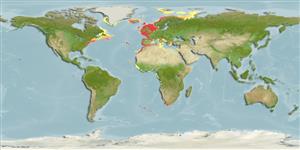Common names from other countries
Classification / Names / Names
Common names | Synonyms | Catalog of Fishes (gen., sp.) | ITIS | CoL | WoRMS
Environment: milieu / climate zone / depth range / distribution range
Ecology
Sessile. Temperate
Northeast Atlantic and the Mediterranean: North and Celtic seas.
Length at first maturity / Size / Weight / Age
Maturity: Lm ? range ? - ? cm
This is an attached species (Ref. 3123). Epibenthic (Ref. 87524) from circalittoral and bathyal zones (Ref. 85338). Solitary (Ref. 2377).
Life cycle and mating behavior
Maturity | Reproduction | Spawning | Eggs | Fecundity | Larvae
Members of the class Anthozoa are either gonochoric or hermaphroditic. Mature gametes are shed into the coelenteron and spawned through the mouth. Life cycle: The zygote develops into a planktonic planula larva. Metamorphosis begins with early morphogenesis of tentacles, septa and pharynx before larval settlement on the aboral end.
Ellis, J.R., G. Burt and S.I. Rogers. 2007. (Ref. 87524)
IUCN Red List Status (Ref. 130435)
CITES status (Ref. 108899)
Not Evaluated
Not Evaluated
Human uses
| FishSource |
Tools
More information
Age/Size
Growth
Length-weight
Length-length
Morphology
Larvae
Abundance
Internet sources
Estimates based on models
Preferred temperature
(Ref.
115969): 6.7 - 12.9, mean 8.5 (based on 253 cells).
Price category
Unknown.
